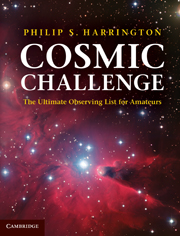Book contents
- Frontmatter
- Contents
- Preface
- Acknowledgments
- Photo credits
- 1 Meeting the challenge
- 2 Naked-eye challenges
- 3 Binocular challenges
- 4 Small-scope challenges: Giant binoculars, 3- to 5-inch telescopes
- 5 Medium-scope challenges: 6- to 9.25-inch telescopes
- 6 Large-scope challenges: 10- to 14-inch telescopes
- 7 Monster-scope challenges: 15-inch and larger telescopes
- Epilogue: The edge of imagination
- Appendix A The cosmic challenge
- Appendix B Suggested further reading
- Appendix C 100 challenging double stars
- Index
7 - Monster-scope challenges: 15-inch and larger telescopes
Published online by Cambridge University Press: 06 December 2010
- Frontmatter
- Contents
- Preface
- Acknowledgments
- Photo credits
- 1 Meeting the challenge
- 2 Naked-eye challenges
- 3 Binocular challenges
- 4 Small-scope challenges: Giant binoculars, 3- to 5-inch telescopes
- 5 Medium-scope challenges: 6- to 9.25-inch telescopes
- 6 Large-scope challenges: 10- to 14-inch telescopes
- 7 Monster-scope challenges: 15-inch and larger telescopes
- Epilogue: The edge of imagination
- Appendix A The cosmic challenge
- Appendix B Suggested further reading
- Appendix C 100 challenging double stars
- Index
Summary
This final chapter throws down the gauntlet. Today's largest backyard telescopes, defined here as 15 inches in aperture or larger, have the capacity to show us sights that only a few years ago were either unknown entirely or, at the very least, not understood. All require good viewing conditions, whether that is excellent transparency, steady seeing, freedom from light pollution, or a combination of all three.
How many of these ultimate challenges can you see?
One of my favorite binocular open clusters in the entire sky is M44, the Beehive Cluster or Praesepe, in Cancer the Crab. It's a wonderful target through just about any pair of binoculars. Even the smallest, cheapest pair will show a rich vault of stars. Nine of the brightest stars near the center of the cluster form a distinctive V asterism that is sometimes called the Heart of the Crab. The Heart points toward the southwest and always attracts attention.
Hidden among the stars of M44 are no fewer than eight distant galaxies. Until 1987, most of us knew nothing of them. That was the year when the Uranometria 2000.0 star atlas was published. It showed the sky to a depth never before captured in a convenient star atlas format, and immediately shed light on thousands of objects that no amateurs, except possibly for a few extreme deep-sky hunters, even knew existed.
The biggest problem in spotting the galaxies beyond the Beehive is not their dimness, although that is clearly a factor.
- Type
- Chapter
- Information
- Cosmic ChallengeThe Ultimate Observing List for Amateurs, pp. 367 - 447Publisher: Cambridge University PressPrint publication year: 2010

